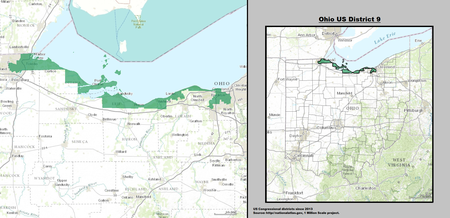Ohio Offers Its Own Solution to Gerrymandering [MAPS + GRAPHS]
Voters overwhelmingly approved change to who draws the Buckeye State’s congressional maps.
Michigan voters could decide whether to change the way the state’s political maps are drawn. A state elections board voted to place the Voters Not Politicians-initiated proposal on the November ballot, which would create an independent commission to design the districts for the state legislature and Congress representatives.
Opponents have asked the Michigan Supreme Court to keep the measure off the ballot. In Ohio, residents have already weighed in on the issue.
Ohioans have been debating the issue for years. The first redistricting initiative was introduced in 1981. Two more followed in 2005 and 2012. Both failed.
Then, in 2014, the Ohio General Assembly created a new commission to draw state legislative boundaries. Voters approved it the following year. In May 2018, they addressed congressional lines by passing Issue 1. It requires that 65 of Ohio’s 88 counties be kept whole in the next U.S. House redistricting process. Catherine Turcer of Common Cause Ohio says it creates bigger building blocks for new districts and will discourage gerrymandering.
“It means we’re not going to have the crazy ‘snake on the lake’ that we have here,” Turcer said. “It’s literally a district that goes from Toledo to Cleveland, and it jumps over a county with a bridge, and at points is not much wider than a yard.”

Turcer referred to District 9, which hugs the Lake Erie shoreline. It’s one of four congressional districts held by Ohio Democrats. Republicans occupy the other 12. That’s a 3-to-1 advantage for the GOP, which has large supermajorities in the Ohio legislature. Turcer says convincing Republican leaders in Columbus to support redistricting reform wasn’t easy. To do so meant ensuring lawmakers got first crack at drawing new maps.
“The argument was ‘we the legislature were given this task of drawing these district lines directly in the U.S. Constitution, and we want to be able to continue to do that.,'” Turcer says. “This is a responsibility the legislature is unwilling to give up.”
While the process still starts in the Ohio General Assembly, it doesn’t necessarily end there. Before new congressional boundaries can take effect, they must be approved by 60 percent of lawmakers in each chamber. Issue 1 also requires support from 50 percent of the legislature’s two largest parties. If the 10-year plan doesn’t meet those standards, it goes to the 7-member commission established in 2015. If it fails there, it goes back to the legislature, where it would not need as a high a threshold to pass. Almost 75 percent of Ohio voters approved Issue 1.
Turcer, of Common Cause, says that shows bipartisanship is possible.
“You know, it’s incredible to think that in this highly polarized time that Democrats and Republicans came together to do something so that our elections are more meaningful.”–Catherine Turcer.
Issue 1 does not change the present makeup of the Ohio General Assembly, where Republicans hold two-thirds of the seats. But Turcer says it should put pressure on politicians to follow the new law and not try to get around it.
“I think it’s reasonable to be leery that they’re going to struggle, which is one of the reasons why I think voters are going to be—need to be very vigilant, and really participate during 2021,” Turcer says. “In fact that tool for mapmaking, that greater transparency, will help urge the legislature to do a better job.”
Ohio’s congressional boundaries will remain in place for two more elections. The 2020 Census will determine what shape future districts will take.
Here’s other WDET work on the gerrymandering issue:
Policy Meets the People: Introducing the Issue of Gerrymandering
Talk Show Programming
WATCH HERE: A live one-hour show with an in-studio audience and guests at 8 p.m., Tuesday, June 26. Tune in at 101.9 FM or online at WDET.org. Or join on WDET’s Facebook page where we’ll live stream the show. The show rebroadcasts at 2 p.m. Tuesday, July 3. Listen HERE for WDET 101.9 FM live online.
On DETROIT TODAY: Was Racism Involved in the Drawing of Michigan’s Congressional Districts?
Digital Specials
A Podcast Playlist – Become a Gerrymandering Expert Just By Listening
NPR’s Hidden Brain: Gerrymandering and You
News Coverage
MichMash: Here’s How You Can Influence The Drawing of District Lines in Michigan
Gerrymandering: Why It’s a Technology Issue [TRANSCRIPT]
Redistricting 101: Your District, Your Politicians, But Does Your Vote Matter?
Ohio Offers Its Own Solution to Gerrymandering [MAPS + GRAPHS]
Who Should Draw Michigan’s Political Maps? Voters May Decide [PHOTOS + MAP]
Voters Not Politicians: The Pros [TRANSCRIPT]
Voters Not Politicians: The Cons [TRANSCRIPT]
It’s a Ship….No, it’s a House…Wait, it’s a Congressional District?
Does Michigan Have a District that Looks Like Homer Simpson? You Be the Judge.
